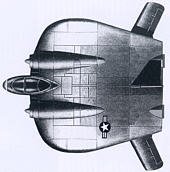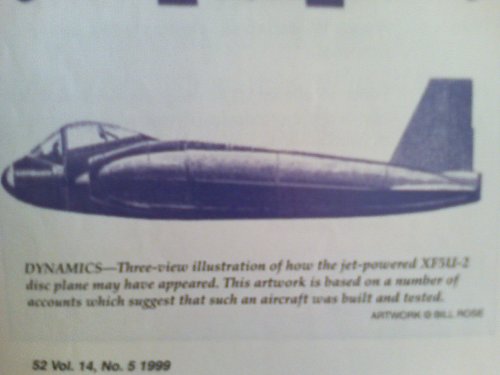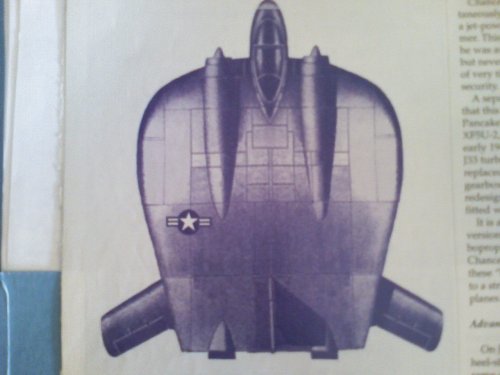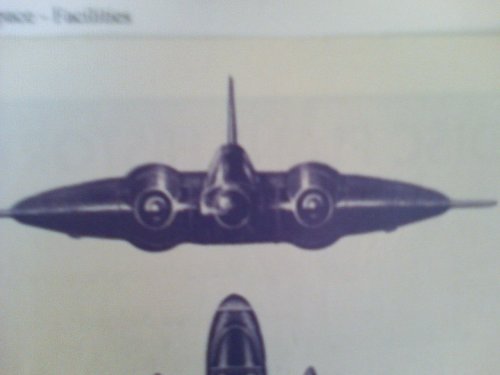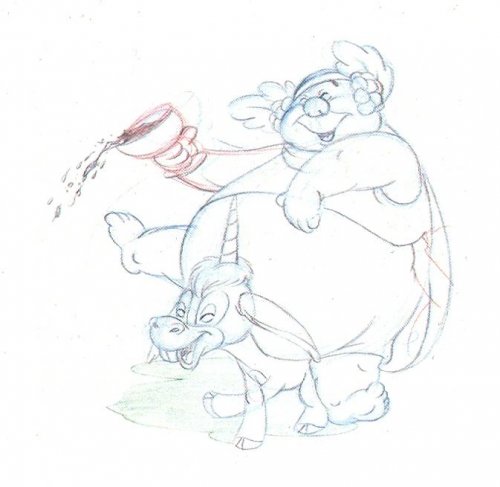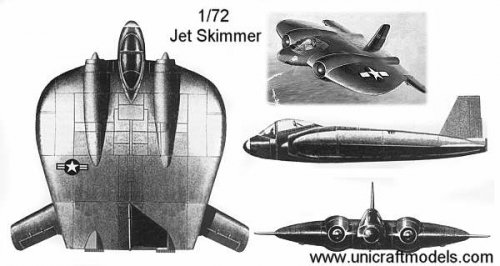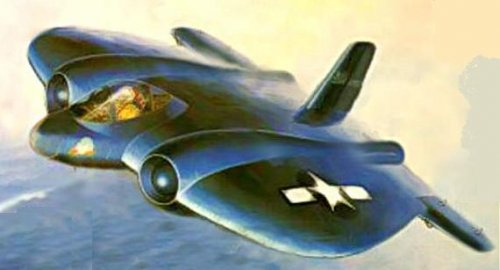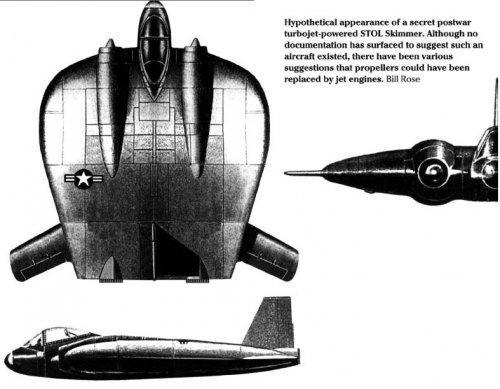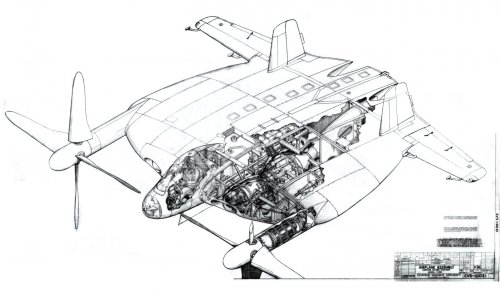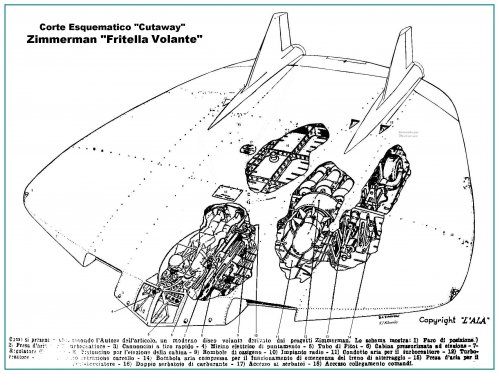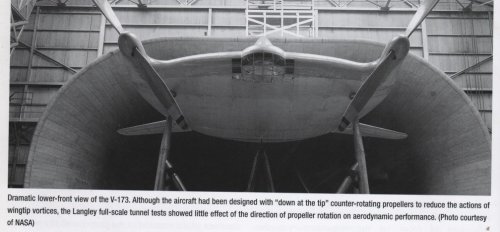You are using an out of date browser. It may not display this or other websites correctly.
You should upgrade or use an alternative browser.
You should upgrade or use an alternative browser.
Jet Powered Vought F5U-2 "Flying Pancake"
- Thread starter hesham
- Start date
I have seen some references to a J33 jet-powered version of the XF5U but these are mostly of conspiratorial in nature and no evidence is provided. I don't see how the original concept would even work with turbojet at all. Turboprop might be a different matter...
A
avatar
Guest
shouldn't this be in postwar secretprojects?
- Joined
- 11 March 2006
- Messages
- 8,640
- Reaction score
- 3,286
I think, FarSight is quite right. A jet powered XF5U would have lost its original
"raison d'etre" as a fighter with very good STOL capabilities. In fact, the conceot
started as a kind of a tailsitter.With jet engines, it probably looks cool, but I don't
know, which aerodynamic advantages it would have had .
"raison d'etre" as a fighter with very good STOL capabilities. In fact, the conceot
started as a kind of a tailsitter.With jet engines, it probably looks cool, but I don't
know, which aerodynamic advantages it would have had .
A
avatar
Guest
it would also have had a huge cross section if it banked! ;D
Hi I have lost a three-view drawing of the Flying Pancake (JET VERSION) :'(
Could someone help , please?
Could someone help , please?
XP67_Moonbat
ACCESS: Top Secret
- Joined
- 16 January 2008
- Messages
- 2,252
- Reaction score
- 402
- Joined
- 4 May 2008
- Messages
- 2,440
- Reaction score
- 701
I knew there was a jet version of the XF5U, but I had not seen the drawings. Thanks for sharing.
As a side note, I don't think a jet powered flapjack would have been a good idea. Seems to me the whole concept needs propeller slipstream to work. By putting jets (especially early generation ones) on that platform, you get something even trickier than a Cutlass to takeoff and land.
Speaking of taking off, is there any description of the proposed landing gear?
As a side note, I don't think a jet powered flapjack would have been a good idea. Seems to me the whole concept needs propeller slipstream to work. By putting jets (especially early generation ones) on that platform, you get something even trickier than a Cutlass to takeoff and land.
Speaking of taking off, is there any description of the proposed landing gear?
saturncanuck
Any landing you can walk away from, is a good one.
Yes, the jet concept would have negated the whole concept.
see http://www.secretprojects.co.uk/forum/index.php/topic,6203.msg51198.html#msg51198
see http://www.secretprojects.co.uk/forum/index.php/topic,6203.msg51198.html#msg51198
Just call me Ray
ACCESS: Top Secret
- Joined
- 26 August 2007
- Messages
- 672
- Reaction score
- 44
Justo Miranda said:Many thanks my friend!
This toast to you ...
Hah hah, I love that movie!
...if I can only remember which one it was.... ???
Retrofit
ACCESS: Top Secret
- Joined
- 21 February 2007
- Messages
- 646
- Reaction score
- 290
Just call me Ray said:Justo Miranda said:Many thanks my friend!
This toast to you ...
Hah hah, I love that movie!
...if I can only remember which one it was.... ???
Fantasia, Walt Dysney,1940, (Beethoven: 6th Symphony)
http://www.youtube.com/watch?v=jvButzoSEPk
XP67_Moonbat
ACCESS: Top Secret
- Joined
- 16 January 2008
- Messages
- 2,252
- Reaction score
- 402
Oh my bad.  Fictional huh? You know, it wouldn't look too out of place in a sci-fi film, now that you mention it.
Fictional huh? You know, it wouldn't look too out of place in a sci-fi film, now that you mention it.
- Joined
- 4 May 2008
- Messages
- 2,440
- Reaction score
- 701
saturncanuck said:Yes, the jet concept would have negated the whole concept.
see http://www.secretprojects.co.uk/forum/index.php/topic,6203.msg51198.html#msg51198
I was reading in "Radical wings" that apparently the V-173 was tested in a wind tunnel with the props rotating in both directions (tips going up outboard/ tips going down) and they found very small differences in lift and drag. They did measure a much larger change in longitudinal stability. this must be somewhere on an NACA report on the NTRS, it would be interesting to dig that up and read the actual details.
Matej
Multiuniversal creator
- Joined
- 8 January 2006
- Messages
- 1,605
- Reaction score
- 699
Not to be pedantic, but shouldn't the title be "F5U-2", not "F3U-2"?
I'm not too sure that a turbojet version would do that well, a turboprop version, though....
Absolutely correct, sorry ! Corrected :-[
I'm not too sure that a turbojet version would do that well, a turboprop version, though....
Absolutely correct, sorry ! Corrected :-[
elmayerle said:I'm not too sure that a turbojet version would do that well, a turboprop version, though....
Maybe like this one:
Attachments
- Joined
- 25 June 2009
- Messages
- 13,941
- Reaction score
- 3,574
JimK said:Maybe like this one:
Very nice image indeed, but I believe this is simply the XF5U-1 prototype.
Which begs the question: wouldn't a jet powered version have been considered a different aircraft altogether? And if so, why call it F5U-2? Do we have any sort of document to back up this designation? Or is it pure invention?
Given the greater power-to-weight of a turboprop engine, it's interesting to speculate how a turboprop variant of the XF5U-2 would have compared to the later Convair XFY-1 Pogo and Lockheed XFV-1 Salmon. I suspect that a turboprop pancake would have been a lot less complex and easier to operate in practice.
- Joined
- 25 June 2009
- Messages
- 13,941
- Reaction score
- 3,574
sienar said:But that image clearly shows a turboprop engine.
The drawing is also labled as V-341, which is described as "XF5U special powerplant research" in the vought designations thread
Indeed. Sorry for looking at the drawing too hastily.
I agree that turboprops would have been perfect for this aircraft (and also for a few others). It's a shame that the technology was not yet matured at the time.
John Frazer
I really should change my personal text
- Joined
- 1 January 2018
- Messages
- 26
- Reaction score
- 38
- Joined
- 19 July 2016
- Messages
- 3,827
- Reaction score
- 2,819
The moonbat name in the first pictures is actually the XP-67.
- Joined
- 13 June 2007
- Messages
- 2,065
- Reaction score
- 2,495
The XP-67 never had the "Moonbat" name applied to it by McDonnell Aircraft or the Army Air Force. Best I can tell, that was added by a magazine writer/editor.
Enjoy the Day! Mark
Enjoy the Day! Mark
Re: Jet Powered "Flying Pancake"
Just to be clear, here, the S.J.Sikorsky whose name appears on that cutaway, is the illustrator and not the better known Igor Ivanovich Sikorsky nor one of his sons or daughter.
John Frazer said:from the flying flapjacks thread, Sikorsky applying himself to the problem
Just to be clear, here, the S.J.Sikorsky whose name appears on that cutaway, is the illustrator and not the better known Igor Ivanovich Sikorsky nor one of his sons or daughter.
- Joined
- 7 June 2009
- Messages
- 525
- Reaction score
- 127
I always had a doubt about the very existence of this jet version of Skimmer. Isn't it a fake "project"? Simply I don't see any sense for this. Zimmerman's concept was remarkable for it's incredible low-speed flight and STOL abilities, and the props (very unusual props, I need to say) were an important part of the whole concept. Would such an aircraft have any advantages against more traditional counterparts if it would be equipped with jets?
- Joined
- 19 July 2016
- Messages
- 3,827
- Reaction score
- 2,819
Thanks Mark. Why would there be a problem with a jet powered version, it is just a means of propulsion and the wing/section of fuselage provides the lift and controlability. I know I have seen this mentioned and Profile Publications the source but I cannot say when the item was published as mine was long ago given away by my mother.
- Joined
- 8 March 2009
- Messages
- 965
- Reaction score
- 986
Foo Fighter said:Thanks Mark. Why would there be a problem with a jet powered version, it is just a means of propulsion and the wing/section of fuselage provides the lift and controlability. I know I have seen this mentioned and Profile Publications the source but I cannot say when the item was published as mine was long ago given away by my mother.
The whole point of the design is to have the propellers at the wing tips cancelling the vortex generated at the wing tip and thus making the low aspect ratio wing much more efficient than it would normally be.
sienar said:Foo Fighter said:Thanks Mark. Why would there be a problem with a jet powered version, it is just a means of propulsion and the wing/section of fuselage provides the lift and controlability. I know I have seen this mentioned and Profile Publications the source but I cannot say when the item was published as mine was long ago given away by my mother.
The whole point of the design is to have the propellers at the wing tips cancelling the vortex generated at the wing tip and thus making the low aspect ratio wing much more efficient than it would normally be.
Also, I seem to remember, is the prop-wash over the wing surface was an important part, especially at slow speeds. I've read that the earlier flying pancake when flown in tests (can't remember where but could be a Ginter book), that it almost looked like it was 'hovering' but in fact was just keeping up with the carrier's forward speed.
As I understand the issue, any low-aspect ratio wing is inefficient in terms of lift because too much of the high-pressure air under the wing leaks to the low-pressure area on top, by flowing around the comparatively long wing tip. The vortices generated by the F5U's big propellers acted in the opposite direction and cancelled out this flow to make the disk-like wing practical.
Otherwise, low-aspect ratio wing designs require some sort of wing-tip fence to block the adverse flow, like you sometimes see on short-span, broad-chord, home-built light aircraft. But the fences usually add enough drag and weight to be impractical.
One type of wing-tip fence has proved itself, however, by improving the efficiency of HIGH-aspect ratio wings: the upswept winglets found on airliners, business jets, and some agricultural aircraft. They work like fences (or F5U vortices). Modern materials and aerodynamics reduce the associated weight and drag penalties.
So I can't see how a jet could fulfill the same function--at least, not when buried in the fuselage.
Otherwise, low-aspect ratio wing designs require some sort of wing-tip fence to block the adverse flow, like you sometimes see on short-span, broad-chord, home-built light aircraft. But the fences usually add enough drag and weight to be impractical.
One type of wing-tip fence has proved itself, however, by improving the efficiency of HIGH-aspect ratio wings: the upswept winglets found on airliners, business jets, and some agricultural aircraft. They work like fences (or F5U vortices). Modern materials and aerodynamics reduce the associated weight and drag penalties.
So I can't see how a jet could fulfill the same function--at least, not when buried in the fuselage.
John Frazer
I really should change my personal text
- Joined
- 1 January 2018
- Messages
- 26
- Reaction score
- 38
The low-aspect ratio plane, like the Boeing 396, did not need the props counter-spinning over the wingtips. The Arup plane was what gelled Zimmerman's concept for a VTOL twin-rotor craft; He worked for NACA and was on the team that saw the Arup S-2 fly and it made slow landings, and flew 97+mph on 37 horsepower. It did not exhibit any supposed detrimental excessive drag due to wing-tip vortices at cruise low "A" flight. It was sleek and quick, as an all-wing.
It was after that, when he designed a low-aspect-ratio twin-rotor hovering craft. His early patents show plainly that's what the twin props were for. Another patent showed landing gear suited to it.
Look at the NASA Studies of the Wainfan Facetmobile. At low speed very high A flight, you want the huge wing-tip vortices, to maximize lift in such slow conditions and to keep the flow from the leading edge over the top of the wing from separating, to allow the low-speed flight. You wouldn't want to counter it if you could. As it turns out, The V-173 didn't counter them. It still made the super-slow flight, despite the counter-props.
It seems to be a myth that all low-aspect ratio planes suffer high drag due to those supposed vortices. They're not present at cruise. Many examples show this.
The huge giggle-factor inducing props were an un-necessary complication, and the gearing system for them doomed the XF5U to being impossible.
If the Navy had contracted Boeing to build the 396, as an honest study of the Arup planform, things might have been different.,
A jet would have done fine.
Why the Navy agreed that the huge silly flappy twin props over the wing-tips were necessary, we can't know.
We might call the V-173 "Zimmerman's folly" or how the Navy threw away the Boeing low aspect-ratio fighter.
It was after that, when he designed a low-aspect-ratio twin-rotor hovering craft. His early patents show plainly that's what the twin props were for. Another patent showed landing gear suited to it.
Look at the NASA Studies of the Wainfan Facetmobile. At low speed very high A flight, you want the huge wing-tip vortices, to maximize lift in such slow conditions and to keep the flow from the leading edge over the top of the wing from separating, to allow the low-speed flight. You wouldn't want to counter it if you could. As it turns out, The V-173 didn't counter them. It still made the super-slow flight, despite the counter-props.
It seems to be a myth that all low-aspect ratio planes suffer high drag due to those supposed vortices. They're not present at cruise. Many examples show this.
The huge giggle-factor inducing props were an un-necessary complication, and the gearing system for them doomed the XF5U to being impossible.
If the Navy had contracted Boeing to build the 396, as an honest study of the Arup planform, things might have been different.,
A jet would have done fine.
Why the Navy agreed that the huge silly flappy twin props over the wing-tips were necessary, we can't know.
We might call the V-173 "Zimmerman's folly" or how the Navy threw away the Boeing low aspect-ratio fighter.
Last edited:
John Frazer
I really should change my personal text
- Joined
- 1 January 2018
- Messages
- 26
- Reaction score
- 38
AeroFranz wrote
I found images of that model, but the two-bladed props were fitted to spin outboard, as if to counter wing-tip vortices. I'd like to see more of the studies with them spinning the opposite direction -or to find images of such props fitted.
This seems to confirm that the V-173 did not need the huge flapping counter-props for it's low speed landings, nor to be effective in low-A cruise. The vortices are not present in cruise, only in low speed very high "A" flight.
(edit)
I just reserved/requested a copy of that to my local library.
https://www.amazon.com/Radical-Wings-Wind-Tunnels-Advanced/dp/1580071163
I was reading in "Radical wings" that apparently the V-173 was tested in a wind tunnel with the props rotating in both directions (tips going up outboard/ tips going down) and they found very small differences in lift and drag. They did measure a much larger change in longitudinal stability. this must be somewhere on an NACA report on the NTRS, it would be interesting to dig that up and read the actual details.
I found images of that model, but the two-bladed props were fitted to spin outboard, as if to counter wing-tip vortices. I'd like to see more of the studies with them spinning the opposite direction -or to find images of such props fitted.
This seems to confirm that the V-173 did not need the huge flapping counter-props for it's low speed landings, nor to be effective in low-A cruise. The vortices are not present in cruise, only in low speed very high "A" flight.
(edit)
I just reserved/requested a copy of that to my local library.
https://www.amazon.com/Radical-Wings-Wind-Tunnels-Advanced/dp/1580071163
John Frazer
I really should change my personal text
- Joined
- 1 January 2018
- Messages
- 26
- Reaction score
- 38
Verified, from the book "Radical Wings" that the props did nothing much for it. Slight improvement in drag, at low-speed high-A flight, but that high drag was not present in normal flight. As in most discussions, it haphazardly mixes discussion of cruise and low speed which were two distinct and very different realms, contradicting itself.
The book first talks about the Arup S-2 which impressed them with it's good speed 84 kts on a 37HP engine. It does not go into way they persisted in thinking it needed the props rotating down-at-the-tips as if to counter wing-tip wash-around. It just matter-of-fact states that's what the Navy contracted him and Vought to build, ignoring everything previously established about the Arup having good speed (= good efficiency in the air), while having the silly slow landing speed.
After plainly stating that there was little effect to the down-at-the-tip or flapping-prop configuration, it then matter-of-fact states that's what Vought sought to do with the XF5U -apparently for no good reason.
It did not need the outward-rotating props.
The book first talks about the Arup S-2 which impressed them with it's good speed 84 kts on a 37HP engine. It does not go into way they persisted in thinking it needed the props rotating down-at-the-tips as if to counter wing-tip wash-around. It just matter-of-fact states that's what the Navy contracted him and Vought to build, ignoring everything previously established about the Arup having good speed (= good efficiency in the air), while having the silly slow landing speed.
After plainly stating that there was little effect to the down-at-the-tip or flapping-prop configuration, it then matter-of-fact states that's what Vought sought to do with the XF5U -apparently for no good reason.
It did not need the outward-rotating props.
Attachments
Similar threads
-
-
Vought Spanloader Flying-Wing Aircraft
- Started by hesham
- Replies: 2
-
USAF CARA Competition and its Projects
- Started by hesham
- Replies: 13
-
-
Colonial Twin Skimmer Amphibian Project
- Started by hesham
- Replies: 0

